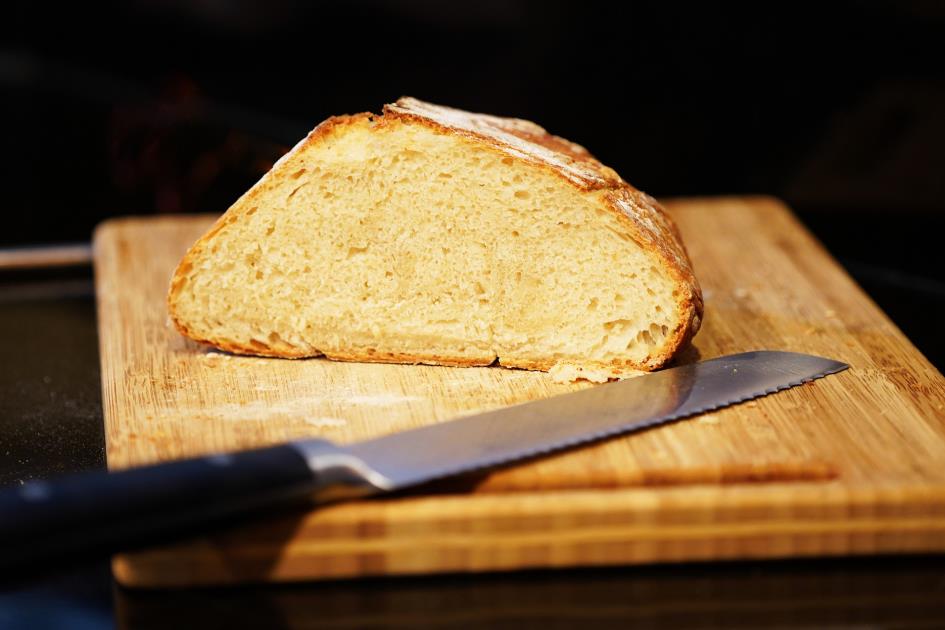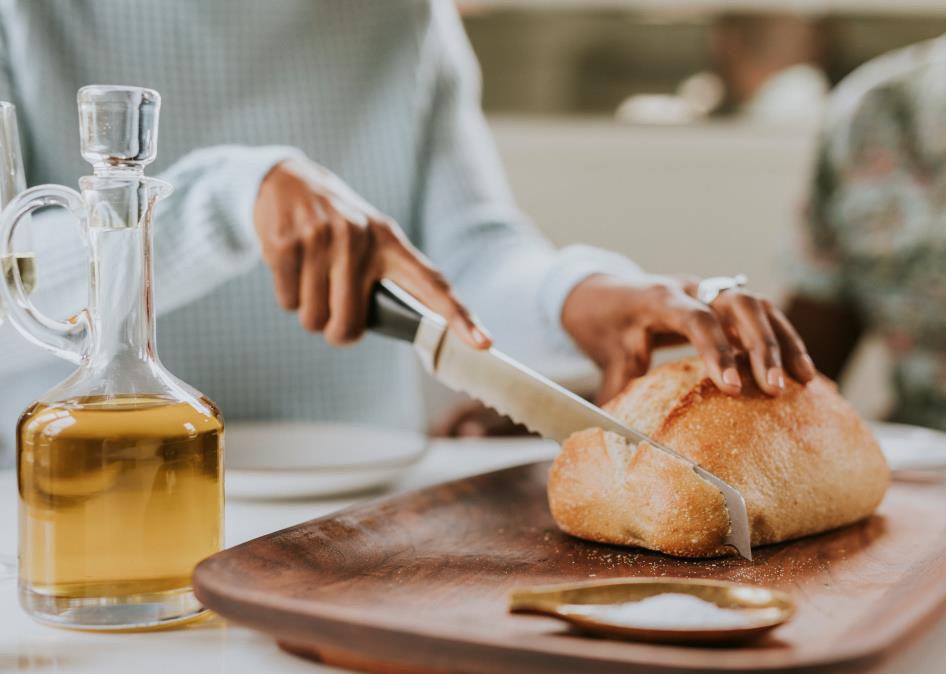Whether you’re looking for a durable kitchen knife or a beautiful and intricate collectible, Japanese knives will never disappoint. While the focus may be on sushi chefs and their trusty sushi knives, or the all-purpose gyuto, one Japanese knife doesn’t get nearly enough attention: the Pankiri.
Picture a bread knife, but with a touch of Japanese flair. That’s essentially what a Pankiri knife is. However, given the changes in technology and cross-border influence in knife manufacturing, it’s no surprise that the Pankiri has seen its fair share of changes and iterations. Still, it remains one of the most useful but often overlooked knives in any kitchen.
So what exactly is a Pankiri knife, and what sets it apart from other bread knives? Below we discuss all you need to know about Pankiri knives, including their parts, features, and uses.
Table of contents
What is a Pankiri?

A Pankiri knife is a Japanese bread knife characterized by its long, serrated blade. In Japanese, Pan translates to “パン”, meaning bread, and Kiri means “to slice”. As the name suggests, the primary purpose of a Pankiri knife is slicing bread. However, its serrated blade allows it to handle other ingredients like soft fruits and vegetables.
The Pankiri knife is essentially the Japanese equivalent of the Western bread knife. It shares many of the same features, like a long serrated blade, but often with a few subtle differences that make it uniquely Japanese.
For instance, the steel used in forging a Pankiri knife is harder than that used in manufacturing a bread knife. As a result, the Japanese Pankiri can retain its edge for longer. Additionally, Japanese Pankiri knives often feature a Wa-handle, the traditional Japanese handle style. In contrast, bread knives typically have the Yo-handle.
While the design of the Wa-handle may differ depending on the knife maker, it is usually made from wood and shaped like an octagon or D-shape. The result is a more comfortable and ergonomic grip. Given the quality of steel used and the intricate handle designs, Pankiri knives often come with a hefty price tag.
Handpicked for you
True cutting power in the palm of your hand
Parts of a Pankiri
Like any knife, a Pankiri knife comprises several key parts that work together to allow for precise and efficient slicing. Below are features and designs you can expect to find on a typical Pankiri knife.
Pankiri knife features and designs
The defining feature of a Pankiri knife is its long, serrated blade. Serrations are small teeth-like indentations running along the blade. They help the blade grip and slice through tough bread crusts with ease. These serrations come in two forms, scalloped and pointed.
- Scalloped serrations: Scalloped serrations are more subtle and have a gentle wave-like shape. They appear like half moon shapes running along the blade. Because of their shape, scalloped serrations are great at slicing through soft foods without tearing or crushing them.
- Pointed serrations: Pointed serrations are sharper and more defined. They feature teeth-like points that help the blade grip and slice through tougher bread crusts. Given their shape, pointed serrations are also great at cutting through tougher-skinned fruits and vegetables like eggplants and tomatoes.
Below are other features and designs of a Pankiri knife you should know about:
- Handle type: Pankiri knives feature either a Wa-handle or Yo-handle. Handles can either be ornate or simple in design. Wa handles are traditional Japanese handles made of wood. They can either be D-shaped or oval-shaped and often come with intricate carvings. On the other hand, Yo handles are more contemporary and typically made of plastic or synthetic materials.
- High-quality steel material: Pankiri knives feature harder steel than other western knives. This kind of steel ensures excellent edge retention and sharpness. Examples of steel used in a Pankiri knife are VG-10 and AUS-8.
- Long blade: A Pankiri knife has a long blade that can range from six to ten inches. The long blade allows for longer and smoother slicing strokes. Although a longer blade can be more challenging to control, it’s easier to slice through larger food items with a Pankiri knife.
Pankiri knife uses

The features and design of a Pankiri knife incline it to a few primary uses. Unlike a bread knife, the Pankiri has harder steel, making it perfect for more than just slicing bread. Listed below are some of the most common uses of a Pankiri knife:
Cut bread
The most obvious and primary use of a Pankiri knife is to slice bread. The serrated blade and the long length of the Pankiri knife make it easy to slice through even the toughest bread crust.
Bread variations may include baguettes, pretzels, rolls, buns, and loaves. These variations come in textures, such as crusty, chewy, fluffy, and soft. Using a straight-edged knife to cut any bread variations will result in jagged and torn slices. As such, a Pankiri knife is the ideal tool for slicing bread.
When using a Pankiri knife to cut bread, the key is to maintain a vertical slicing motion. This back and forth movement helps prevent the bread from tearing. Holding the bread still with one hand, use the other hand to guide the blade in a sawing motion. Slice through the bread until you reach the desired thickness.
Certain types of vegetables and fruits
The material design of a Pankiri knife also allows it to cut certain types of vegetables and fruits. The hard steel can slice through vegetables, such as carrots, celery, radishes, and turnips. The scalloped blade is also ideal for slicing softer fruits, such as tomatoes, kiwis, peaches, and nectarines.
When cutting vegetables, it’s important to use a slicing motion rather than a chopping motion. This style is to prevent the vegetables from bruising or becoming mushy. Start by slicing the vegetables lengthwise into thin strips before cutting them into smaller pieces. For softer fruits, use a gentle sawing motion to slice through them.
Do you need a pankiri?

A Pankiri knife is an excellent addition to any kitchen. Its close alternative is the bread knife, but as we now know, differences in quality and design make the Pankiri knife a better option in some instances. Its versatility in cutting bread and certain fruits and vegetables makes it a worthy investment for any home cook or professional chef.
When deciding if you need a Pankiri knife, consider what you typically like to cook and serve. If you often find yourself slicing bread or cutting softer fruits and vegetables, then a Pankiri knife will definitely come in handy. However, if you rarely prepare meals requiring more than a basic kitchen knife, then a Pankiri knife may not be necessary.
Pankiri knife (FAQs)
Will a Pankiri knife cut through meat?
The Pankiri knife is sharp enough to cut through meat, but it’s not the ideal tool for the job. To get clean cuts of meat, it’s best to use a chef’s knife or a slicing knife. Pankiri knives are perfect for slicing bread and cutting softer fruits and vegetables.
How do I care for my Pankiri knife?
The best way to care for your Pankiri knife is to clean and sharpen it regularly. After each use, wash the knife with soap and water. Then, dry it off with a clean towel. Avoid putting the knife in the dishwasher, as this can damage the blade. Sharpen the blade every few months to keep it in top condition.
Closing
Pankiri knives are an essential kitchen tool for anyone who loves to cook. Its versatility in cutting bread and certain fruits and vegetables makes it a worthy investment for any home cook or professional chef. So, the next time you’re in the market for a new kitchen knife, be sure to add a Pankiri knife to your collection.
Also, visit our blog for information on different kitchen knives and their uses. Our store has several kitchen knives that will make your cooking experience better. Make sure to check us out.












